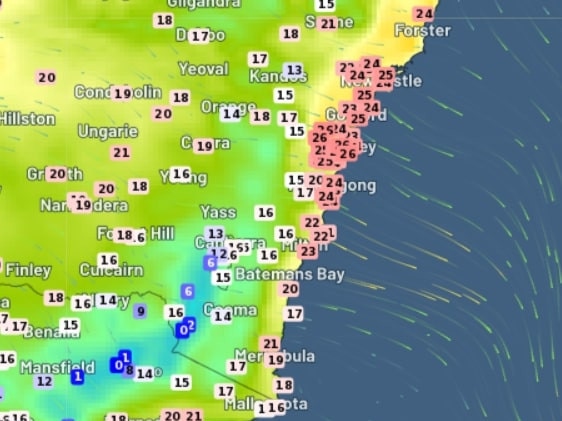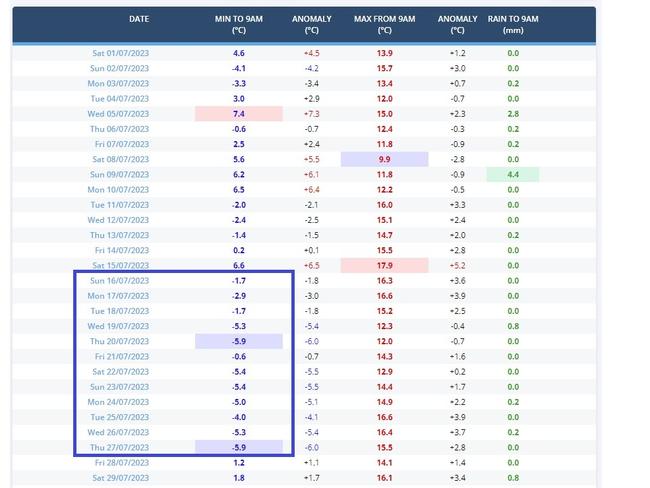Australia’s ‘scorching’ midwinter temperatures explained
Millions of Australians have sweated through an unseasonably hot end to July, usually the coldest month of the year.

Environment
Don't miss out on the headlines from Environment. Followed categories will be added to My News.
Sydney has sweltered through an abnormally hot end to July, usually the year’s coldest, as temperatures continue to climb across the country.
The city’s Observatory Hill recorded a whopping 25.2C on Sunday – 9C above Sydney’s long-term average for the same period of just 16.4C.
Weatherzone reported the temperature was only just outside of the January long-term average of 26C, despite being midwinter.
The weather agency also revealed that Penrith, in Sydney’s far west, recorded the fourth highest temperature statewide of 26.4C on Sunday.
Grafton in the state’s Northern Rivers region was NSW’s hottest having recorded temperatures over the weekend of a whopping 27C.
Warm ocean temperatures have been blamed for causing the hot spell, according to Weatherzone.
It reported a warm north-westerly pushing across southeast Australia thanks to a low-pressure system near Tasmania.

The widespread weather movement meant areas as south as East Gippsland in Victoria were treated to rare temperatures above 20C.
Melbourne reached almost 19C on Friday, before dipping slightly over the weekend, while further South Hobart reached 18.4C on Saturday.
Weatherzone likewise reported Brisbane as reaching a whopping 28C on Monday – the first day of August – after reaching 25.7C on Sunday.
The reading is on-par with average temperatures recorded in Brisbane throughout the months of November and December 2022.
The warm weather comes after global temperature records were shattered last month, with warnings July could be the hottest month ever.
Large swathes of southern Europe including Greece and Spain, as well as the Mediterranean country of Algeria, battled out of control wildfires.
The United States meanwhile faced devastating heatwaves with the Arizona city of Phoenix recording 30 consecutive days above 43C.
Check out the national weekly weather forecast with Senior Meteorologist Angus Hines.
— Bureau of Meteorology, Australia (@BOM_au) July 31, 2023
Video current at 1.30pm AEST, Monday 31 July 2023.
For the latest forecasts and warnings go to our website https://t.co/4W35o8iFmh or the BOM Weather app. pic.twitter.com/9gLhRTCwYb
Closer to home, the weather has brought fresh warnings over a potentially devastating bushfire season in large parts of NSW later this year.
Prime Minister Anthony Albanese warned residents in Shoalhaven, a fire-ravaged region of the south coast, it was impossible to “defy science”.
“We’ve just been through an incredible wet period. But the climatologists tell us that it’s going to be a dry season coming up,” he said.
More immediately, Sydney is expected to stay above 20C until next weekend, with a top temperature forecast for Friday of 23C.
Rain remains unlikely over the week, according to BOM, with a 70 per cent chance of falls forecast for Sunday and Monday.
Melbourne is also set for another scorcher with BOM forecasting the city to reach a whopping 20C on Thursday.

Temperatures will cool there over the following weekend amid a 90 per cent chance of 1-15mm of rain forecast for Friday.
Brisbane is forecast to reach 25C on Tuesday, before reaching a maximum of 23C throughout the coming week and weekend.
Canberra, meanwhile, will reach a high of 19C on Thursday, off the back of one of its frostiest July months on record.
Weatherzone reported Canberra had recorded 18 days of negative temperatures in July, two days more than the monthly average.
Adelaide will reach a high of 23C on Thursday before falling to 14C over the weekend, while Hobart will reach a maximum of 18C the same day.
Darwin will remain steady throughout the week with maximum temperatures of 32-33C; Perth, amid heavy rains, will reach just 18C.
Originally published as Australia’s ‘scorching’ midwinter temperatures explained


